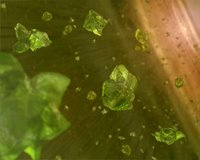 | Mission: Spitzer Space Telescope (SST), Spacecraft: Spitzer Space Telescope (SST), Product Size: 3000 samples x 2400 lines, Produced By: California Institute of Technology. |
Original Caption Released with Image: This artist's concept shows microscopic crystals in the dusty disk surrounding a brown dwarf, or "failed star." The crystals, made up of a green mineral found on Earth called olivine, are thought to help seed the formation of planets.
NASA's Spitzer Space Telescope detected the tiny crystals circling around five brown dwarfs, the cooler and smaller cousins of stars. Though crystallized minerals have been seen in space before -- in comets and around other stars -- the discovery represents the first time the little gem-like particles have been spotted around confirmed brown dwarfs.
Astronomers believe planets form out of disks of dust that circle young brown dwarfs and stars. Over time, the various minerals making up the disks crystallize and begin to clump together. Eventually, the clumps collide and stick, building up mass like snowmen until planets are born.
NASA images generally are not copyrighted. Unless otherwise noted, images and video on JPL public web sites (public sites ending with a jpl.nasa.gov address) may be used for any purpose without prior permission. The endorsement of any product or service by Caltech, JPL or NASA must not be claimed or implied.
Leave a comment, make a request, Let this small sampling be a guide to better quality, more plentiful, public domain, royalty free, copyright free, high resolution, images, stock photos, jpeg, jpg, free for commercial use, clip art, clipart, clip-art. more at Public Domain Clip Art and clip art or public domain and Brown Dwarfs or NASA and Spitzer Space Telescope or Space Science and olivine or Alien and California Institute of Technology or planets













No comments:
Post a Comment